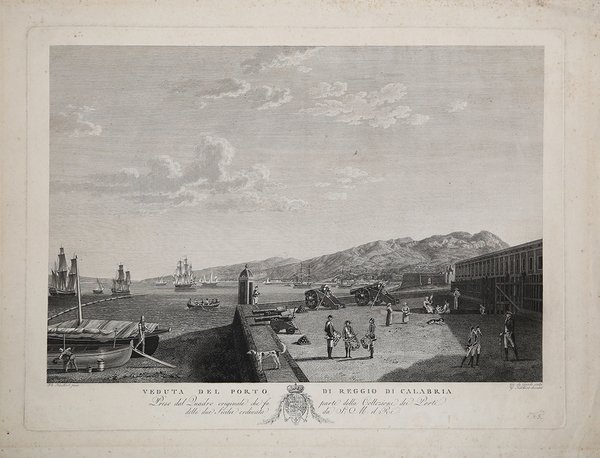Acquaforte, ultima decade del XVIII secolo, firmata da Giovanni de Grado e Georg Abraham Hackert che traduce a stampa e pubblica il celebre dipinto del fratello Jakob Philipp Hackert appartenente alla serie Vedute dei Porti del Regno conservati nella Reggia di Caserta. Influenzato dai paesaggi di Claude Lorrain e dagli artisti olandesi del XVII secolo, il tedesco Jakob Philipp Hackert (1737-1807) fu uno dei più grandi artisti di paesaggio con sede a Roma fine XVIII secolo. I suoi precisi rendering di siti belli e storici hanno attirato una clientela internazionale durante il Grand tour europeo. Nel 1785 su richiesta del re Ferdinando IV di Borbone si stabilì a Napoli, dopo aver raggiunto il successo grazie a un incarico ricevuto dalla zarina Caterina II di Russia (1782). Presso la corte borbonica, dove lavorò insieme al fratello incisore George Abraham (1755-1805), fu nominato Primo Pittore di Corte con l'incarico di dipingere le vedute più care al re, di consigliarlo sull'acquisto di opere d'arte e di occuparsi dell'educazione artistica dei principi. Inoltre, Hackert curò per il re il trasporto della Collezione Farnese da Roma a Napoli, il restauro dei dipinti della Pinacoteca Reale e la decorazione dei nuovi siti reali di San Leucio e Carditello. Il pittore non aveva ancora portato a compimento la serie dei primi dei dipinti richiestigli quando il Re, nel 1788, gli ordinò di recarsi in Puglia per effettuare un rilevamento topografico complessivo della costa adriatica, con le sue baie ed i suoi porti. Tra il 1789 e il 1792 Hackert ne trasse almeno nove vedute, principiando dal golfo di Manfredonia, scendendo fino al tacco dello stivale, per poi risalire sullo Jonio verso Taranto. Un corpus di studi preparatori alle tele di grande formato della suite dei porti del regno, oggi conservato al Kupferstichkabinett di Berlino, testimonia il lavoro scrupoloso e capillare che sottende la realizzazione delle vedute e dà conto delle numerose prove grafiche che precedevano la stesura dei dipinti. La Reggia di Caserta conserva nelle proprie Collezioni numerose sue opere, comprese le Vedute dei Porti del Regno, commissionate per la Villa Favorita di Resina e divenute modello per un'intera scuola napoletana di pittori per il paesaggio dal vero. La veduta viene stampata a Napoli da Georg Abraham Hackert che dirige e incarica dell’incisione il suo allievo Giovanni de Grado. Bellissima prova, impressa su carta vergata coeva, in ottimo stato di conservazione. Bibliografia Il paesaggio secondo natura, Jacob Philipp Hackert e la sua cerchia, A cura di: Paolo Chiarini; A. Grimaldi, Le Vedute dei Porti del Regno: Jacob Philipp Hackert, Il vedutista al servizio del Re, pp- 313-335; T. Weidner, Jakob Philipp Hackert, Berlino 1998. ' Etching, last decade of the 18th century, signed by Giovanni de Grado and Georg Abraham Hackert, who translated into print and published the famous painting by his brother Jakob Philipp Hackert belonging to the series Views of the Ports of the Kingdom preserved in the Royal Palace of Caserta. Influenced by the landscapes of Claude Lorrain and 17th-century Dutch artists, German Jakob Philipp Hackert (1737-1807) was one of the greatest landscape artists based in Rome late 18th century. His precise renderings of beautiful and historic sites attracted an international clientele during the European Grand Tour. In 1785 at the request of King Ferdinand IV of Borbone he settled in Naples, having achieved success through a commission he received from Tsarina Catherine II of Russia (1782). At the Bourbon court, where he worked together with his engraver brother George Abraham (1755-1805), he was appointed First Court Painter with the task of painting the views dearest to the king, advising him on the purchase of works of art, and dealing with the artistic education of the princes. In addition, Hackert oversaw for the king the transport of the Farnese Collection from Rome to Naples, the restoration of paintings in the Royal Picture Gallery, and the decoration of the new royal sites of San Leucio and Carditello. The painter had not yet completed the series of the first of the paintings requested of him when the king, in 1788, ordered him to travel to Apulia to make an overall topographical survey of the Adriatic coast, with its bays and ports. Between 1789 and 1792 Hackert drew at least nine views from it, starting from the Gulf of Manfredonia, going down to the heel of the boot, and then up the Ionian Sea toward Taranto. A corpus of preparatory studies for the large-format canvases of the suite of ports of the kingdom, now preserved at the Kupferstichkabinett in Berlin, testifies to the painstaking and thorough work underlying the creation of the views and gives an account of the numerous graphic proofs that preceded the drafting of the paintings. The Royal Palace of Caserta holds many of his works in its Collections, including the Views of the Ports of the Kingdom, commissioned for the Villa Favorita in Resina and which became the model for an entire Neapolitan school of painters for landscapes from life. The views were printed in Naples by Georg Abraham Hackert, who directed and commissioned his pupil Giovanni de Grado to do the engraving. Beautiful proof, printed on contemporary laid paper, with margins, very good condition. Bibliografia Il paesaggio secondo natura, Jacob Philipp Hackert e la sua cerchia, A cura di: Paolo Chiarini; A. Grimaldi, Le Vedute dei Porti del Regno: Jacob Philipp Hackert, Il vedutista al servizio del Re, pp- 313-335; T. Weidner, Jakob Philipp Hackert, Berlino 1998. Cfr.


Découvrez comment utiliser
Découvrez comment utiliser

